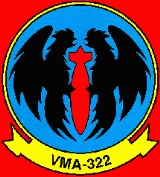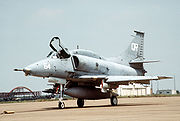
VMA-322
Encyclopedia
Marine Attack Squadron 322 (VMA-322) was a fighter squadron in the United States Marine Corps
. The squadron, also known as the “Fighting Gamecocks”, fought in World War II
and later became a part of the Marine Forces Reserve based out of Naval Air Station South Weymouth
, Massachusetts
.
flying the F4U Corsair
. In the fall of that year they moved to Marine Corps Recruit Depot Parris Island
, South Carolina
to continue their training. They moved again in January, 1944 to Marine Corps Air Station Ewa
, Hawaii
.
In October, 1944, the squadron became part of Marine Aircraft Group 33 (MAG-33) when they moved to Espiritu Santo
. The squadron was part of the Battle of Okinawa
and on April 3, 1945 over 150 of its members were killed when its lead support element was struck by a Kamikaze. They rebounded quickly and were able to fly their first combat mission on April 9, 1945. VMF-322 remained on Okinawa for the rest of the war as they made bombing runs over the Japanese mainland
. Following the war, the squadron moved to Midway Island
in November 1945 where they remained as part of Marine Aircraft Group 44 (MAG-44) until they were deactivated on November 30, 1949.

 VMF-322 was reactivated during the Korean War
VMF-322 was reactivated during the Korean War
on July 6, 1951 again flying the F4U Corsair. The squadron moved to Naval Air Station South Weymouth
in January 1954 and transitioned to the F9F Cougar
in March 1955. The squadron changed it name to Marine Attack Squadron 322 (VMA-322) in May 1958 and changed aircraft again, this time to the FJ3 Fury
in November 1959. In September 1962 the squadron received its final aircraft in the venerable A-4 Skyhawk
. In 1964, VMA-322 absorbed the aircraft and personnel of VMA-217
after their deactivation.
VMA-322 was decommissioned on June 27, 1992 as part of the post-Cold War
drawdown of the United States Military
United States Marine Corps
The United States Marine Corps is a branch of the United States Armed Forces responsible for providing power projection from the sea, using the mobility of the United States Navy to deliver combined-arms task forces rapidly. It is one of seven uniformed services of the United States...
. The squadron, also known as the “Fighting Gamecocks”, fought in World War II
World War II
World War II, or the Second World War , was a global conflict lasting from 1939 to 1945, involving most of the world's nations—including all of the great powers—eventually forming two opposing military alliances: the Allies and the Axis...
and later became a part of the Marine Forces Reserve based out of Naval Air Station South Weymouth
Naval Air Station South Weymouth
Naval Air Station South Weymouth, or SOWEY as it is sometimes known, was an operational United States Navy airfield from 1942 to 1997. It was first established as a regular Navy blimp base during World War II...
, Massachusetts
Massachusetts
The Commonwealth of Massachusetts is a state in the New England region of the northeastern United States of America. It is bordered by Rhode Island and Connecticut to the south, New York to the west, and Vermont and New Hampshire to the north; at its east lies the Atlantic Ocean. As of the 2010...
.
History
Marine Fighting Squadron 322 (VMF-322) was established on July 1, 1943 at Marine Corps Air Station Cherry PointMarine Corps Air Station Cherry Point
Marine Corps Air Station Cherry Point or MCAS Cherry Point is a United States Marine Corps airfield located in Havelock, North Carolina, USA, in the eastern part of the state...
flying the F4U Corsair
F4U Corsair
The Vought F4U Corsair was a carrier-capable fighter aircraft that saw service primarily in World War II and the Korean War. Demand for the aircraft soon overwhelmed Vought's manufacturing capability, resulting in production by Goodyear and Brewster: Goodyear-built Corsairs were designated FG and...
. In the fall of that year they moved to Marine Corps Recruit Depot Parris Island
Marine Corps Recruit Depot Parris Island
Marine Corps Recruit Depot Parris Island is an military installation located within Port Royal, South Carolina, approximately south of Beaufort, the community that is typically associated with the installation. MCRD Parris Island is used for the training of enlisted Marines...
, South Carolina
South Carolina
South Carolina is a state in the Deep South of the United States that borders Georgia to the south, North Carolina to the north, and the Atlantic Ocean to the east. Originally part of the Province of Carolina, the Province of South Carolina was one of the 13 colonies that declared independence...
to continue their training. They moved again in January, 1944 to Marine Corps Air Station Ewa
Marine Corps Air Station Ewa
Marine Corps Air Station Ewa was a United States Marine Corps air station that was located west of Pearl Harbor on the island of Oahu, Hawaii. The base was hit during the attack on Pearl Harbor, and later served as the hub for all Marine aviation units heading into combat in the Pacific Theater...
, Hawaii
Hawaii
Hawaii is the newest of the 50 U.S. states , and is the only U.S. state made up entirely of islands. It is the northernmost island group in Polynesia, occupying most of an archipelago in the central Pacific Ocean, southwest of the continental United States, southeast of Japan, and northeast of...
.
In October, 1944, the squadron became part of Marine Aircraft Group 33 (MAG-33) when they moved to Espiritu Santo
Espiritu Santo
Espiritu Santo is the largest island in the nation of Vanuatu, with an area of . It belongs to the archipelago of the New Hebrides in the Pacific region of Melanesia. It is in the Sanma Province of Vanuatu....
. The squadron was part of the Battle of Okinawa
Battle of Okinawa
The Battle of Okinawa, codenamed Operation Iceberg, was fought on the Ryukyu Islands of Okinawa and was the largest amphibious assault in the Pacific War of World War II. The 82-day-long battle lasted from early April until mid-June 1945...
and on April 3, 1945 over 150 of its members were killed when its lead support element was struck by a Kamikaze. They rebounded quickly and were able to fly their first combat mission on April 9, 1945. VMF-322 remained on Okinawa for the rest of the war as they made bombing runs over the Japanese mainland
Japan
Japan is an island nation in East Asia. Located in the Pacific Ocean, it lies to the east of the Sea of Japan, China, North Korea, South Korea and Russia, stretching from the Sea of Okhotsk in the north to the East China Sea and Taiwan in the south...
. Following the war, the squadron moved to Midway Island
Midway Atoll
Midway Atoll is a atoll in the North Pacific Ocean, near the northwestern end of the Hawaiian archipelago, about one-third of the way between Honolulu, Hawaii, and Tokyo, Japan. Unique among the Hawaiian islands, Midway observes UTC-11 , eleven hours behind Coordinated Universal Time and one hour...
in November 1945 where they remained as part of Marine Aircraft Group 44 (MAG-44) until they were deactivated on November 30, 1949.
Cold War


Korean War
The Korean War was a conventional war between South Korea, supported by the United Nations, and North Korea, supported by the People's Republic of China , with military material aid from the Soviet Union...
on July 6, 1951 again flying the F4U Corsair. The squadron moved to Naval Air Station South Weymouth
Naval Air Station South Weymouth
Naval Air Station South Weymouth, or SOWEY as it is sometimes known, was an operational United States Navy airfield from 1942 to 1997. It was first established as a regular Navy blimp base during World War II...
in January 1954 and transitioned to the F9F Cougar
F9F Cougar
The Grumman F9F/F-9 Cougar was an aircraft carrier-based fighter aircraft for the United States Navy. Based on the earlier Grumman F9F Panther, the Cougar replaced the Panther's straight wing with a more modern swept wing...
in March 1955. The squadron changed it name to Marine Attack Squadron 322 (VMA-322) in May 1958 and changed aircraft again, this time to the FJ3 Fury
FJ Fury
The North American FJ-2/-3 Fury were a series of swept-wing carrier-capable fighters for the United States Navy and Marine Corps. Based on the United States Air Force's F-86 Sabre, these aircraft featured folding wings, and a longer nose landing strut designed to both increase angle of attack upon...
in November 1959. In September 1962 the squadron received its final aircraft in the venerable A-4 Skyhawk
A-4 Skyhawk
The Douglas A-4 Skyhawk is a carrier-capable ground-attack aircraft designed for the United States Navy and United States Marine Corps. The delta winged, single-engined Skyhawk was designed and produced by Douglas Aircraft Company, and later McDonnell Douglas. It was originally designated the A4D...
. In 1964, VMA-322 absorbed the aircraft and personnel of VMA-217
VMA-217
Marine Attack Squadron 217 was a fighter squadron of the United States Marine Corps that was activated and fought during World War II. Known as “Max’s Wild Hares”, they fought in many areas of the Pacific War including the Battle of Iwo Jima. Following the surrender of Japan, the squadron was ...
after their deactivation.
VMA-322 was decommissioned on June 27, 1992 as part of the post-Cold War
Cold War
The Cold War was the continuing state from roughly 1946 to 1991 of political conflict, military tension, proxy wars, and economic competition between the Communist World—primarily the Soviet Union and its satellite states and allies—and the powers of the Western world, primarily the United States...
drawdown of the United States Military
See also
- United States Marine Corps AviationUnited States Marine Corps AviationUnited States Marine Corps Aviation is the air component of the United States Marine Corps. Marine aviation has a very different mission and operation than its ground counterpart, and thus, has many of its own histories, traditions, terms, and procedures....
- List of active United States Marine Corps aircraft squadrons
- List of inactive United States Marine Corps aircraft squadrons

